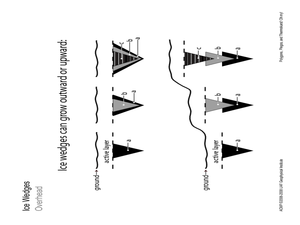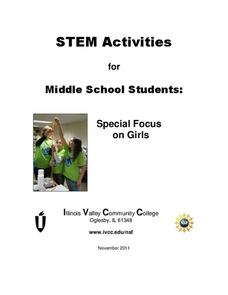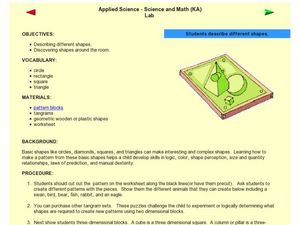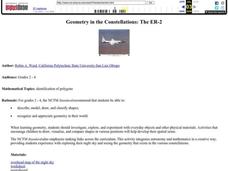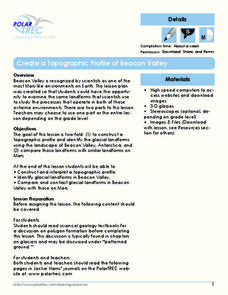Curated OER
Polygons, Pingos, and Themokarst! Oh MY!
Students complete activities to learn about the common land features in Alaska. In this land study lesson, students study an overhead for permafrost features. Students define ice wedge polygons, thermokarst, and pingos. Students also...
Curated OER
Polygons and Vertices
In this geometry worksheet, students analyze different polygons and relate it to a circuit board. They find the odd degree Euler circuit and identify the vertices of the odd degree. There are 3 questions with an answer key.
Curated OER
Strut Your Stuff
Young scholars begin the lesson by identifying what a polygon is and hypothesizing how many struts (diagonals) it would take to make a polygon rigid. They watch a "Magic School Bus" episode then experiment with various shapes to make a...
Curated OER
Tessellations
Students identify and construct figures that tessellate. They investigate which regular polygons tessellate and how to modify them to make other tessellating figures. Students explore how naturally occurring tessellations have been...
Illinois Valley Community College
STEM Activities for Middle School Students
Use STEM activities within the class to provide connections to concepts. The resource includes activities that range from working with buoyancy to building rockets and launching them. Other activities involve the engineering design...
National Nanotechnology Infrastructure Network
Learning About Surface Area and Volume
Plan a dinner party. Using a book by Marilyn Burns as a context, pupils learn about the relationships between area and perimeter and surface area and volume. The hands-on activities have learners rearrange tables and cut up meatballs to...
Curated OER
Shapes and Tools
Young learners view different shapes drawn by the teacher on the board. The teacher identifies each shape by name and discusses the importance of knowing the difference between shapes when building something. The pupils complete the...
Curated OER
Applied Science - Science and Math (K) Lab
In this shape instructional activity, learners cut out tangram shapes and create different pictures with them. They look at 3-D shapes as well. There is a nice, hands-on component built into this instructional activity.
Curated OER
How Many Regular Polyhedrons Are There In This or Any Universe?
Students examine the idea of "regularity" as it pertains to geometry. In this geometry lesson students complete several assignments that are part of trihedral angles and regular polyhedrons.
Curated OER
Geometry in the Constellations: The ER-2
Students discuss reasons to record the location of stars. They view a picture of the night sky, and discuss constellations. Students complete a worksheet of the various shapes they see in the constellations.
Curated OER
How Many Trees Can You Grow?
Young scholars solve a story problem about how many trees can be planted in a given area. Using a map, they gather information about the size of the area and the dimensions of an acre. They use a specific equation to determine the area...
Curated OER
ME*Pro App
In this secondary mathematics lesson, learners investigate the uses and capabilities of a TI-89 application designed for mechanical engineering students. The app contains over 700 pieces of reference information and organized into...
Curated OER
The Honey Bee's Home
Pupils study honey bees by researching handouts and books. In this honey bee lesson plan, students make a comb out of polygons, learn about the 4 stages of insect development, and view how the hive hierarchy works.
Curated OER
Cylinder: Student Worksheet
In this cylinder worksheet, students compare three different cylinders to experiment which one has the greatest volume. Students interact with rectangles as they experiment with the cylinders.
Curated OER
Areas of States - Estimation
Learners estimate the area of states using the formulas for the areas of rectangles, squares, and triangles. In this geometric shapes lesson, students divide irregular shaped states into shapes. They use the formulas for areas of...
Curated OER
Length Lab
In this science instructional activity, students identify and explain what each unit represents and how much each one equals. Then they use a metric ruler to locate each measurement and write it on the line. Students also locate the...
Curated OER
The Unit Factor and Dimensional Analysis
In this unit factor and dimensional analysis worksheet, students read about how to convert from one unit to another using unit factors and how to work with square units and cubic units using dimensional analysis. They practice solving...
Curated OER
Biology Tessellations
Students review three types of polygons that are triangles, squares, and hexagons. They use a computer program to draw various types of tessellations. The students use the drawing of a honeybee as inspiration.
Curated OER
Circles and Squares
In this circles and squares worksheet, learners try to make a circle by only using straight lines and a square. Students follow 4 sets of directions.
Curated OER
The Mysterious Hexagon on Saturn!
In this Saturn instructional activity, students use a photograph of a hexagon feature on Saturn to solve three problems. These include finding the time it takes for the jet stream to complete one circuit around the hexagon, to find the...
Curated OER
Seeing is Believing - Or Is It?
Here is a great science instructional activity. It extends the concept of vision into the area of optical illusions, perspective, and tessellation. This well-designed plan has tons of great activities, utilizes interesting video, and...
Polar Trec
Create a Topographic Profile of Beacon Valley
Landforms in Beacon Valley, Antarctica, where there is no snow, bear a striking resemblance to landforms found on Mars. Scholars identify landforms found in Beacon Valley through analysis of topographic maps in the activity. They then...
Curated OER
Orbital path of Landsat
Students comprehend how Landsat satellites orbit teh Earth to produce images. They comprehend the elliptical path of satellites. Students recognize that a different orbital path is needed for different satellites to perform their tasks....
American Museum of Natural History
Thinking in the Three Dimensions
Discover different dimensions with paper folding. Pupils first read about zero, one, two, and three dimensions, and then learn about the fourth dimension, time. They then use origami to create models of shapes in three dimensions and use...
Other popular searches
- Irregular Polygons
- Classifying Polygons
- Congruent Polygons
- Four Sided Polygons
- Sorting Polygons
- Photos of Polygons
- Area of Polygons
- Compute Areas of Polygons
- Identifying Polygons
- Perimeter of Polygons
- Convex and Concave Polygons
- 2d Polygons
